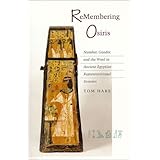
Average Reviews:

(More customer reviews)I recommend this highly to anyone out there who is looking for a really stimulating conjunction of Kemetic thought and postmodern philosophy.
Now, a word of warning, inasmuch as this is no book for the beginner, in two senses. It would help if the Egyptological reader had some familiarity with thinkers like Jacques Derrida and Judith Butler. And by the same token, the reader of critical theory would want some Egyptology under their belt. But the book is well worth the effort for both, and could open the eyes of either significantly.
This book represents a truly unusual convergence, inasmuch as it is in my opinion a valuable contribution both to Egyptology as well as to critical theory. While the author is not himself an Egyptologist, he has steeped himself in the best of contemporary work in the field (especially Erik Hornung and Jan Assman). And there is some virtue in his distance from the field, inasmuch as Hare is able to turn a critical eye on some of the prejudices and presuppositions which are so endemic in interpretations of Kemetic thought.
An extremely rich book, which demonstrates as well that the intellectual tools provided by post-structuralist theory can make a positive and rigorous contribution to research in particular fields.
Click Here to see more reviews about: ReMembering Osiris: Number, Gender, and the Word in Ancient Egyptian Representational Systems
The texts and visual arts of ancient Egypt reveal a persistent and sophisticated engagement with problems of language, the body, and multiplicity. This innovative book shows how these issues were represented in ancient Egypt and how Egyptian approaches to them continue to influence the way we think about them today.The story of Osiris is one of the central cultural myths of ancient Egypt, a story of dismemberment and religious passion that also exemplifies attitudes about personal identity, sexuality, and the transfer of royal power. It is, moreover, a story of death and the overcoming of death, and in this it lies at the center of our own means of engagement with ancient Egypt.This book focuses on the story of Osiris as it is recorded in Egyptian texts and memorialized on the walls of temples and tombs. Since such a focus is attainable only through Egyptian representational systems, especially hieroglyphs, the book also engages broader questions of writing and visual representation: decipherment, controversies about the "ideograph," and the relation between visual images and writing.This analysis of Egyptian representation leads to a consideration of the phallic body and the problem of multiplicity in Egyptian religion, two nets of Egyptian discourse that, though integrated into the writing system itself, reach toward broader Egyptian discourses of gender, subjectivity, piety, and cosmogenesis. The concluding chapter considers, in specific terms, the question of a persisting Egyptian legacy in the West, from the Greeks and Israelites to Augustine, Hegel, and Lacan.

0 comments:
Post a Comment